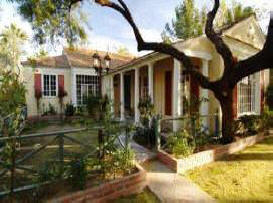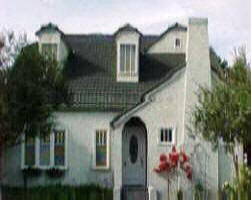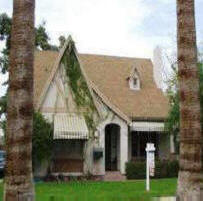Roosevelt Historical District Phoenix Map, History, Roosevelt Row, First Friday Art Walk Information and Homes For Sale
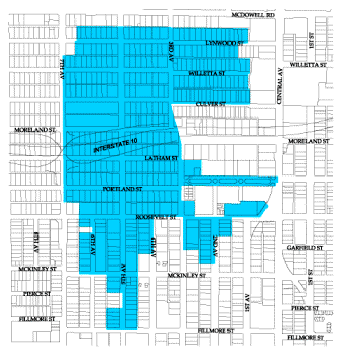
This photo below is an example of an early 1900s Craftsman Bungalow
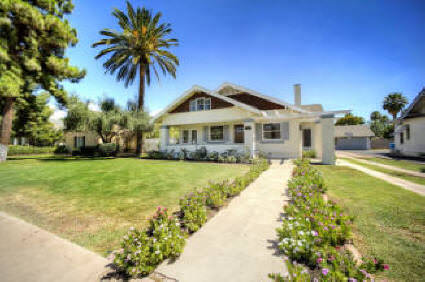
Roosevelt Historic District History
Early Influences
Several factors in the early history of Phoenix account for the development of the area now known as the Roosevelt Neighborhood. From its founding in 1867, Phoenix experienced slow, but steady outward growth. The completion of a connection to the transcontinental railroad in 1884 brought hundreds of new residents and visitors to the Valley. Construction materials such as wood, glass, stone and prefabricated components became available to local builders who soon began to discard the use of adobe and other native materials in an effort to create a city that resembled the rest of the country.
Initially, many prominent residents constructed houses in the southern and eastern portions of the original Phoenix town site. However, severe flooding of the Salt River in 1890 and 1891 caused the more wealthy residents to move north to higher ground along Center Street (now Central Avenue), west along Washington Street and adjacent to the Grand Avenue diagonal. This northward movement altered the growth pattern of Phoenix and accounts for the development of the Roosevelt Neighborhood.
Expansion of the city into the Roosevelt Historic District spans the years 1893 to 1930. The neighborhood developed through the construction of nine distinct additions. Kenilworth and Bennett Place each contained well over 200 lots; Planks Addition had just ten; McDowell Place, fourteen; and the other five (Simms Addition, Bennett and Plank's Addition, Chester Place, Chelsea Place and the Blount Addition to Chelsea Place) ranged from 26 to 134 lots. Many of the city's elite, the pioneers who helped shape Phoenix during its infancy, made their homes in this neighborhood.
Simms Addition
Colonel J.T. Simms came to Arizona in 1881 as a contractor with the Atlantic and Pacific Railroad Company. After building the Arizona Canal with W.J. Murphy between 1883 and 1884, Simms retired to run his ranch and manage his real estate interests. Several years later, some land Simms owned was surveyed and on June 26, 1893, a plat was filed for the area bounded by Central Avenue, Roosevelt, Third Avenue, and Moreland. Simms himself later lived in the area at 1008 North Central. He left Phoenix in 1896 after a sordid divorce and died in Chicago in 1898. Despite the rampant land speculation in Phoenix at the turn-of-the-century, building in the Simms Addition progressed slowly.
Central Avenue, then known as Center Street, was the primary thoroughfare to the business district, and lots along this street were deemed prime residential locations. By 1901, residences fronting Central Avenue had been constructed on all but two lots. Here, in addition to Simms and Melczer, resided the upper crust of Phoenix' early citizens: Charles H. Akers, Secretary of the Territory of Arizona; C.M. Frazier, a prominent attorney who would go on to become Attorney General; Frank R. Cleary, Chairman of the Arizona Water Company; Lloyd B. Christy, Chairman of the Valley Bank of Phoenix; and Ezra W. Thayer, owner of Thayer's Hardware Store.
Despite annexation and the elite status of the area, growth in the balance of the Simms Addition averaged only one home per year until 1920. Then, during the booming twenties, all remaining lots but one were developed. The number of prominent businessmen, lawyers, doctors and city officials making their homes in the addition continued to increase. Among them was Richard E. Sloan, Governor of the Territory of Arizona from 1909 to 1912.
Bennett Place
Guy Bennett was a cattle dealer and real estate speculator who moved to Phoenix from Missouri in about 1884. The area known as Bennett Place, bounded roughly by West Roosevelt and West Fillmore on the north and south, and by Central and Fifth Avenues on the east and west, was platted by Guy and Sadie Bennett in December 1894.
While not geographically the largest of the Roosevelt Neighborhood's nine additions, Bennett Place had the greatest number of lots, 276. Development in Bennett Place was slow, but steady. During the 1890's, the city council embarked on a campaign to annex the area's increasingly populated northern additions. The residents of Bennett Place were resistant. They felt that additional city taxes would be put to use in other areas of the city, rather than benefiting their neighborhood.
The city council was forced to take a series of court actions against the neighborhood. In 1901, the District Court ruled that Bennett Place would be annexed, but would be exempt from city taxes for a period of two years. In turn, however, the city was relieved of any obligation to extend municipal services to the area during that period.
As with Simms Addition, the lots along Central and First Avenues attracted the elite of the city, including Carl Hayden, Arizona's first U.S. Congressman; and Baron M. Goldwater, Manager of Goldwater's Mercantile and father of future Senator Barry Goldwater.
By 1913, growth within the Addition slowed considerably. During the 1920's, developers constructed a number of duplexes and apartments in the area hoping to attract a portion of Phoenix's large number of winter visitors and booming tourist trade. Instead, seizing their chance to live in a more affluent area, an increasing number of blue-collar and middle-class workers made their homes in these new rental properties.
Plank's Addition
First platted by Levi L. Plank in 1901, this small addition consisted of only ten lots along West McKinley between Fifth and Sixth Avenues. No development occurred in Plank's Addition until the 1910 extension of the streetcar line along Fifth Avenue. Still, it wasn't until 1929 that all ten lots were finally developed. The residents were entirely blue-collar workers who lived in bungalows or duplexes.
Bennett and Plank's Addition
McKinley and Fillmore Streets bound this plat, originally part of the two earlier additions, on the north and south, and by Sixth and Seventh Avenues on the east and west. This land was purchased by four families (the Bennetts' the Shoffs' the Peters, and Margaret B. Barringer) who jointly had the area replatted and recorded in November 1910. As late as 1930, less than half of the 34 lots were developed. Most residents of Bennett and Plank's Addition were blue-collar workers who rented, rather than owned, their homes.
Kenilworth Addition
The 80-acre area bounded by West McDowell, Third Avenue, West Roosevelt and Seventh Avenue, was known as the Hubbard Tract until February 1910, when A.G. Hubbard sold the land to developer H.I. Latham. Two weeks later, Latham sold the property to the Hartranft-Tweed Real Estate Company, which filed the plat for the Addition in December. In February 1911, Kenilworth was annexed into the City of Phoenix.
Kenilworth developed into an exclusive residential area due to three major influences: the extension of the Phoenix Railway streetcar line north along Fifth Avenue through the Addition; a vigorous advertising campaign, which went so far as to state that "the air is better in Kenilworth"; and the construction of Kenilworth School in 1920. The streetcar made the area very accessible and initial development in Kenilworth was concentrated along the Fifth Avenue streetcar extension. Palm trees were planted along the streets, which were graded, lined with caliche and featured cement sidewalks. Many prominent residents, such as Supreme Court Justice Donald L. Cunningham, Phoenix National Bank President M.C. McDougall, and J.A.R. Irvine, member of the first State Legislature, made their homes in the area.
Building restrictions during WWI slowed growth in the addition between 1916 and 1920. During the decade that followed, the opening of Kenilworth School and a new concept of low down payments and low monthly installments offered by Home Builders, the primary developer, attracted young families to the area. Rapid growth ensued and the Addition's 228 lots were completely built up by 1938.
McDowell Place
T.M. Burroughs filed the plat for the area encompassing the south side of West McDowell between Central and Third Avenues on January 31, 1910. Despite the small size of the area (which contained just fourteen lots), it was not completely developed until 1930. Its most spectacular residence was an English Cottage Revival built for Helen Anderson, widow of insurance company organizer Carl H. Anderson, at 149 West McDowell Road. In 1923, the Arizona Republican described the house as one of the city's most beautiful homes. Fortunately, this house remains intact at its original address, while most of the other original buildings in McDowell Place have been altered as they have been converted for commercial purposes.
Chester Place
Platted in 1909 by the Elliot Evans Company, Chester Place consists of 52 lots on two blocks bounded by West Roosevelt and West McKinley on the north and south, and by Fifth and Seventh Avenues on the east and west. Development of this Addition proceeded somewhat more rapidly than the others in the Roosevelt Neighborhood, being completed by 1930. Chester Place was a very affluent area whose residents included doctors, lawyers and businessmen.
Chelsea Place
This relatively small parcel, spanning West Lynwood and West Willetta between Central and Third Avenues, was annexed to the city in 1913. H.F. Latham, a Phoenix Promoter and owner of a real estate firm, purchased the land from the estate of William E. Thorne on May 20, 1907, and filed a plat the following July. Eight lots known as Latham Place, between Central and Third Avenues, sold within two days without any advertisement whatsoever. The remainder of the tract was resurveyed into 84 lots and development began in 1912.
Chelsea Place was hailed by the Arizona Republican as "the most expensive and artistic development yet attempted in Phoenix." To enhance its aura of exclusiveness, elaborate street entrances patterned after Los Angeles' exclusive Lafayette Square were constructed. Made of cast concrete to simulate dressed sandstone, these gateways unfortunately no longer exist. Chelsea Place was promoted as a showplace residential development and attracted many affluent residents. However, Home Builders, the primary developer, sold homes on an installment plan with a low down payment, bringing home ownership within reach of the less affluent as well.
Blount Addition
Platted in March 1919, by Frank J. Blount and W.C. Ellis as the Blount Addition to Chelsea Place, the Addition spans both sides of West Culver Street between Central and Third Avenues. Frank Blount was a rancher who had lived on the property facing Central Avenue since 1908. William Ellis was a successful physician and surgeon who founded Deaconess Hospital (later to be renamed Good Samaritan Hospital) and served one term as City Commissioner from 1920-1921. His house is at 1242 North Central.
Development in the Addition proceeded slowly, with eight of the 40 lots still unoccupied by 1930. Its residents were mostly white-collar professionals, although the area was not known for the elitism of Chelsea Place or Kenilworth.
Roosevelt Neighborhood Architecture
As was typical of a "streetcar' I suburb, most of Roosevelt's lots are narrow and deep, minimizing the distance residents must walk to reach transportation. In contrast to the monotony of modern tract neighborhoods, the diversity of housing styles in Phoenix' historic districts gives each a distinctive flavor. Architecturally, the Roosevelt Neighborhood has some of the finest examples of early twentieth century residential architecture in Phoenix. The most common building type in the area is the California Bungalow, which dominates most of the district's streetscape. Among these relatively plain homes also are found many finely detailed Craftsman Bungalows and Period Revival houses. A Bungalow is typically a one-story house with a simple, functional floor plan and one or more broadly pitched roof gables with deep overhangs. Broad front porches with massive square porch columns are an essential feature. Bungalows are the most common type of Craftsman influenced architecture. The Craftsman movement, a popular building philosophy of the early twentieth century, used natural and rustic materials. It stressed comfort, utility and convenience as well as high quality workmanship in design and construction. So-called Craftsman Bungalows were usually covered with natural wood shingles and had foundations, porch columns and chimneys of stone, rough-faced brick or textured concrete.
Roosevelt Historical Neighborhood also includes outstanding examples of public buildings: The Trinity Cathedral, Kenilworth School, and the Westward Ho Hotel. To serve the winter visitors, developers built the Gold Spot Marketing Center, one of the first shopping centers in Phoenix built for a specific residential area. The construction marked the beginning of a trend toward small neighborhood centers away from the original central Phoenix commercial district.
Roosevelt Neighborhood's Significance to Phoenix
As with the other Phoenix historic districts in the City, the development of the Roosevelt Neighborhood provides physical expression of the early growth of Phoenix. Within it are buildings, which are both historically and architecturally important because they represent many important milestones in the evolution of our present community. From its rise as an affluent "streetcar suburb," to its development associated with early tourism, to its designation as the first historic district in Phoenix, the Roosevelt Neighborhood continues to play a significant role in the history of Phoenix. As an intact collection of early twentieth century architecture, it contributes to the visual diversity and character of the historic heart of our community.
Information, maps and photographs provided courtesy:
Historic Preservation Office of the City of Phoenix Neighborhood Services Department
200 West Washington Street
Phoenix, Arizona 85003
(602) 261-8699
ABOUT ROOSEVELT ROW ART'S DISTRICT (RoRo)
Roosevelt Row is a dynamic, walk-able urban mixed-use area with a significant concentration of artists and other creative professionals. With increasing density, this is an area that is becoming more pedestrian-friendly and supportive of small local independent businesses that give downtown Phoenix character. Roosevelt Street is an east-west corridor that connects the historic neighborhoods between Grand Avenue and 16th Street. The corridor also connects Copper Square, Chase Field, U.S. Airways Center, major cultural institutions, the new downtown ASU campus and the biomedical campus.
Roosevelt Row is also home to artist live and work spaces, gallery spaces and studio spaces. Roosevelt Row is a pedestrian friendly street that connects the arts and downtown Phoenix historic neighborhoods including Garfield Historic District, Evans Churchill, F.Q. Story Historical District, Willo Historic District, the Roosevelt Action Association and Grand Avenue.
Roosevelt Row Artists’ District is a walkable, urban, mixed-used creative district in the urban core of downtown Phoenix. It is nationally known for its arts and cultural events, award-winning restaurants, galleries, boutiques and live music. RoRo is fostering an urban renewal with rehabilitated bungalows and new infill projects.
The Artists’ District connects downtown Phoenix to historic neighborhoods including Garfield, Evans Churchill, F.Q. Story, Willo, Roosevelt, Historic Roosevelt and Grand Avenue. Roosevelt Row begins at 7th Avenue and extends east to 16th Street. On the north side it begins at Interstate 10 and extends south to Fillmore Street.
A SHORT BIT OF HISTORY
Roosevelt Row has been a vital mixed use area from the earliest days of the establishment of Phoenix. Many of the concrete sidewalks in the neighborhood were poured in 1909, three years before Arizona officially became the 48th State. In the early 1940's, when there were approximately 30,000 people living in Phoenix, numerous businesses were established along Roosevelt Street. The flower shop at Fifth Street and Roosevelt has been in continuous operation since 1948.
In the 1970's, parts of the area were re-zoned as a high-rise incentive district leading to land speculation and a decline of the neighborhood that lasted until the late 1990's.
The blighted area was attractive to artists because the boarded-up buildings and former crack houses were affordable for studio and gallery space. The arts were a major factor in the revitalization of the area and crime rates plummeted as more people began to venture into the area to experience the cultural vibrancy.
The corridor is re-emerging as one of the most dynamic areas in downtown Phoenix and a valued cultural resource in the metropolitan region and the state.
FIRST FRIDAY'S ART WALK
Downtown Phoenix hosts one of the nation’s largest, self guided artwalks. Roosevelt Row serves as a central hub for the monthly artwalk every First Friday from 6 to 11pm.
Tour galleries, venues and art-related spaces to see a variety of artwork and to enjoy the spirit and culture of the city as you mingle with thousands of other residents and visitors. Free event shuttles are available through out downtown and are headquartered at the Phoenix Art Museum.
Roosevelt Row is a 501(c)3 non-profit organization established to further the unique character and assets of the area, to advocate for the continuing role of the arts in the revitalization of downtown Phoenix, and to foster a dense, diverse and walk-able urban environment.
Schools:
Kenilworth Elementary School (K-8)
1210 N 5th Ave, Phoenix, AZ 85003
602-257-3889
Central High School
4525 N Central Ave, Phoenix, AZ 85012
602-764-7500
Information courtesy of The Roosevelt Row Community Development Corporation.
|
 |

Laura Boyajian
Mobile: 602.400.0008
HistoricCentralPhoenix@cox.net
HomeSmart, LLC - Elite Group
5225 N. Central Ave. #104
Phoenix, AZ 85012
(602) 400.0008
|
